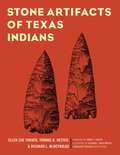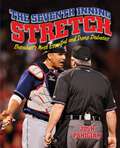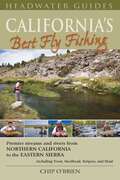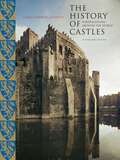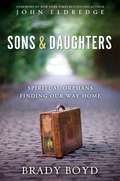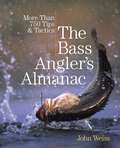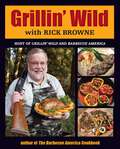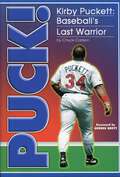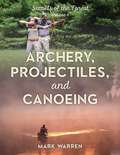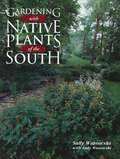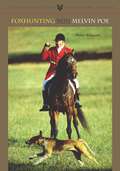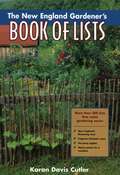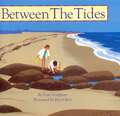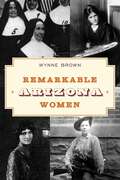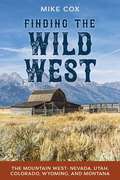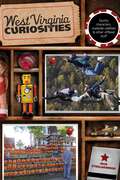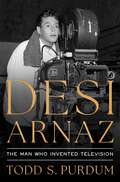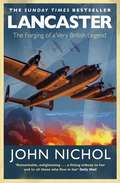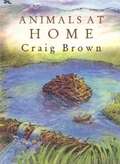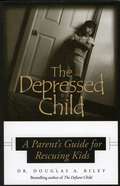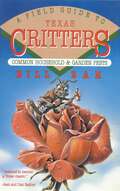- Table View
- List View
Stone Artifacts of Texas Indians
by Thomas R. Hester Ellen Sue Turner Richard L. McReynoldsUseful for academic and recreational archaeologists alike, this book identifies and describes over 200 projectile points and stone tools used by prehistoric Native American Indians in Texas. This third edition boasts twice as many illustrations—all drawn from actual specimens—and still includes charts, geographic distribution maps and reliable age-dating information. The authors also demonstrate how factors such as environment, locale and type of artifact combine to produce a portrait of theses ancient cultures.
Seventh Inning Stretch: Baseball's Most Essential and Inane Debates
by Josh PahigianThe Seventh Inning Stretch, by noted baseball expert Josh Pahigian addresses all of the most interesting baseball arguments, however frivolous, that fans have been engaging in for decades, and even a few they may have never stopped to consider before.
California's Best Fly Fishing
by Chip O'BrienWhether you want to crack the code of Northern California's legendary wild-trout waters, learn the best floats on the Sac, or fish for steelhead, stripers, and shad on the American River, this guide is the best place to start for a successful fishing trip. With stunning photos, detailed maps and hatch charts for each river, photos and recipes of the most effective fly patterns, and insider information from local guides and outfitters, California's Best Fly Fishing is an essential reference for the best fishing in the state.
History of Castles, New and Revised
by Christopher GravettThe History of Castles is the ultimate guide to the world&’s most fascinating castles and strongholds. Chapters include information on castles from France, England, Wales, Scotland, Ireland, Germany, Austria, Switzerland, the Iberian Peninsula, Italy, Scandinavia, Eastern Europe, Russia, and the Middle East. An ideal book for history enthusiasts, people planning to take a vacation near one of these castles, and for anyone who is enamored of these breathtaking buildings.
Sons and Daughters: Spiritual orphans finding our way home
by Brady BoydUsing practical, firsthand stories that offer helpful, portable takeaways, Pastor Boyd looks at the interweaving of his journey from spiritual orphan to treasured son, offering candid stories and freeing insights for every Christian still longing to come home.The truth is, many of us as Christians still strive to “fit in” with God even when our Father offers us the identity of beloved daughters and sons. We’ve already been admitted, approved, and accepted—but we aren’t living that way.In Sons and Daughters, Pastor Boyd looks at the interweaving of God’s grace and our daily lives: How do those who know they are God’s children think, speak, and act differently? How do they function as leaders and friends? How do they walk through pain?You—and the purposes God has for you—are a cause for celebration, a reason to be both fearless and faithful. Come discover how to live like you belong.
Bass Angler's Almanac: More Than 750 Tips & Tactics
by John WeissWith more than 650 tips total, the Almanac is an indispensable reference that will help any bass angler improve his or her fishing success quickly and significantly. An easy-to-read reference and guide, the Almanac is loaded with detailed illustrations and photographs. And it's packed with tips and tidbits that the author has picked up over a lifetime of bass fishing. In it, Weiss examines all types of bass fishing, including: largemouth, smallmouth, and spotted bass biology; tips on reading maps and using sonar; habits of bass in natural lakes, man-made reservoirs, rivers, streams, and strip-mine pits; how weather affects bass; tips on selecting rods, reels, and lines; how to fish live and artificial baits, jigs, soft plastic lures, weedless spoons and jigging spoons; trolling tips that work.
Grillin' Wild
by Rick BrowneGrillin' Wild, a cooking show for hunters and fishermen that many consider the best outdoor cooking show on TV, finds creator and host Rick Browne as the Wild Game Chef, sharing recipes from hunting lodges, resorts, preserves, lakes, rivers, oceans, and campground across North America. Grillin' Wild shares the wonderful recipes, cooking tips, and menu suggestions that have made the TV series popular with Browne's audience. Recipes have been gathered from gulf fishing and wild boar hunting in the steamy swamplands of Florida, a trip to Alaska’s Chigicoff Island for grilled fresh local shrimp, and many other exotic locations. Rick’s new, creative, and easy-to-fix recipes broadly cover the entire range of wild game, game birds, waterfowl, and ocean, lake, and river fish, from Grilled Buffalo Ribeye Steaks with Roquefort Butter, Curried Bear Meatballs, and Grilled Gator Kabobs to Snow Goose with Brandy Sauce, Grilled Halibut with Crab and Shrimp Sauce, and Basil-Ginger Swordfish Steaks.
Puck Kirby Puckett
by Chuck CarlsonThis is the story of Kirby Puckett and his remarkable journey from the projects of the south.
Archery, Projectiles, and Canoeing: Secrets of the Forest
by Mark WarrenIn this fourth volume of the &“Secrets of the Forest&”series, outdoor educator Mark Warren describes the details of how to make and operate the tools that hurl projectiles toward a target including:· &“firing&” techniques of a sling, spear, atl-atl, bow and arrow, throwing knife, tomahawk, and blowgun.· a comprehensive lesson in the art of archery that includes the direct, lob, and clout shots, as well as shooting at a moving target.· primitive precision methods of creating your own Cherokee self-bow and rivercane arrows.· cementing projectile skills through a gamut of games and challenges.The second half of the book provides lessons on tandem canoeing, beginning on a lake or pond and evolving to whitewater. The pre-education of paddling starts on a creek with a self-made model boat to understand the dynamics of moving water. On the lake, using a full-sized canoe, paddlers learn how to take control of their craft. Once on current, paddlers are introduced to the never-relenting march of moving water, a phenomenon that must figure into every river maneuver, from planning routes by &“reading&” the water, eddy turns, lateral ferry maneuvers, peel-outs, hovering in place, and running rapids &“dry,&” to river-rescue of capsized boats and &“swimmers,&” and the joy and instruction of slalom. This volume contains more than two hundred original adventures.
Big Cat the Proud
by Molly PearceA tale of how a mighty but arrogant bulldozer learns the value of friendship and cooperation from an industrious little loader. Full-color illustrations.
Gardening with Native Plants of the South
by Sally WasowskiIn today's South, where fine gardening is a tradition, many homeowners and professional gardeners are discovering a vast new palette of plant materials—native plants. They are realizing that these native wildflowers, trees, shrubs, groundcovers, vines, and grasses are far better suited, and therefore easier to grow and maintain, than most of the imported plants that populate traditional landscapes. Discover the Wasowskis' exciting vision of the many possibilities and advantages of going native.
Foxhunting with Melvin Poe (The Derrydale Press Foxhunters' Library)
by Peter WinantsFoxhunting is in Melvin Poe's blood. As a child, he hunted with hounds owned by his grandfather and father in Rappahannock County, Virginia, and he became the professional huntsman for the Old Dominion Hounds for 16 seasons and the Orange County Hunt for 27 years. He is now, at age 82, in his eleventh year as huntsman for the Bath County Hounds. In 1979, Melvin was featured in the film documentary "Thoughts on Hunting. "Author Peter Winants, a lifelong foxhunter, has been the field master at Bath County since the founding of the hunt in 1992. His book ably captures the essence of one of the most legendary and colorful characters in American foxhunting. In addition to Melvin's upbringing, chapters deal with breeding and training foxhounds, his techniques in finding and hunting foxes and the strategies that have led to immense success through the years at hound shows. The final chapter, "Thanks, Melvin," has testimonials from a number of prominent foxhunters who have enjoyed sport with Melvin, including Benjamin H. Hardaway III, Jacqueline Kennedy Onassis and Senator John W. Warner. Foxhunting With Melvin Poe is must reading for foxhunters and anyone who enjoys the countryside and nature.
The New England Gardener's Book of Lists
by Karan Davis CutlerThe New England Gardener's Book of Lists contains essential information for anyone gardening in the unique climates of the upper northeast. This vital guide provides expert advice on choosing appropriate annuals, biennials, and perennials, tending bulbs, roses, shrubs, and vines, and selecting trees, native plants, ferns, grasses, and groundcovers for particular conditions.
Between the Tides
by Fran HodgkinsWhat happens to the denizens of the tidal zone when the sea recedes every 12 hours? This is the question that Hodgkins answers in a playful yet instructive way. Children are introduced to crabs, sea urchins, mussels, sea worms, starfish, lobsters, periwinkles, and other creatures that must adapt to constantly changing conditions. Previously announced spring 2006.
Remarkable Arizona Women
by Wynne BrownMoving portraits of seventeen independent women who helped make Arizona what it is todayRemarkable Arizona Women profiles the lives of seventeen of the state&’s most fascinating figures—women from across Arizona, from many different backgrounds, and from various walks of life. Read about Sister Mary Fidelia McMahon, designer of a thriving Tucson hospital; Sharlot Mabridth Hall, poet and territorial historian;Pearl Hart, the original lady bandit; and Polingaysi Qöyawayma, a Hopi educator of thousands of young people. With enduring strength and compassion, these remarkable women broke through social, cultural, or political barriers to make contributions to society that still have an impact today. The third edition features new biographies of Laura Kerman, the Tohono O&’odham seed saver; Sara Plummer Lemmon, nineteenth-century botanist and artist; and Ayra Hammonds Hackett, the only African American female newspaper owner in Arizona—and one of very few in the entire country. Each of these women demonstrated an independence of spirit that is as inspiring now as it was then. Read about their extraordinary lives in this captivating collection of biographies.
Finding the Wild West: Nevada, Utah, Colorado, Wyoming, and Montana
by Mike CoxFrom the famed Oregon Trail to the boardwalks of Dodge City to the great trading posts on the Missouri River to the battlefields of the nineteenth-century Indian Wars, there are places all over the American West where visitors can relive the great Western migration that helped shape our history and culture. This guide to the Mountain West states of Nevada, Utah, Colorado, Wyoming, and Montana--one of the five-volume Finding the Wild West series--highlights the best preserved historic sites as well as ghost towns, reconstructions, museums, historical markers, statues, works of public art that tell the story of the Old West. Use this book in planning your next trip and for a storytelling overview of America&’s Wild West history.
West Virginia Curiosities: Quirky Characters, Roadside Oddities & Other Offbeat Stuff (Curiosities Series)
by Rick SteelhammerLaugh your way through the pages of West VirginiaCuriosities, your round-trip ticket to the wildest, wackiest, most outrageous people, places, and things the Mountain State has to offer!
The Young Eagle: The Rise of Abraham Lincoln
by Kenneth J. WinkleDrawing on the latest interpretive and methodological advances in historical scholarship, The Young Eagle: The Rise of Abraham Lincoln reexamines the young adult life of America's sixteenth president.
Best Easy Day Hikes Aspen (Best Easy Day Hikes Series)
by Tracy SalcedoSituated in Colorado's spectacular Roaring Fork Valley, Aspen offers high-country charm, superb downhill skiing, and some of the greatest hiking trails in North America. These day hikes, a sampler of Aspen's outdoor wonders, explore the world-famous Maroon Bells, the Grottos of White River National Forest, the banks of the picturesque Roaring Fork River, and much more. An indispensable guide for Aspen vacationers.
Desi Arnaz: The Man Who Invented Television
by Todd S PurdumAn illuminating biography of Desi Arnaz, the visionary, trailblazing Cuban American who revolutionized television and brought laughter to millions as Lucille Ball&’s beloved husband on I Love Lucy, leaving a remarkable legacy that continues to influence American culture today.Desi Arnaz is a name that resonates with fans of classic television, but few understand the depth of his contributions to the entertainment industry. In Desi Arnaz, Todd S. Purdum offers a captivating biography that dives into the groundbreaking Latino artist and businessman known to millions as Ricky Ricardo from I Love Lucy. Beyond his iconic role, Arnaz was a pioneering entrepreneur who fundamentally transformed the television landscape. His journey from Cuban aristocracy to world-class entertainer is remarkable. After losing everything during the 1933 Cuban revolution, Arnaz reinvented himself in pre-World War II Miami, tapping into the rising demand for Latin music. By twenty, he had formed his own band and sparked the conga dance craze in America. Behind the scenes, he revolutionized television production by filming I Love Lucy before a live studio audience with synchronized cameras, a model that remains a sitcom gold standard today. Despite being underestimated due to his accent and origins, Arnaz&’s legacy is monumental. Purdum&’s biography, enriched with unpublished materials and interviews, reveals the man behind the legend and highlights his enduring contributions to pop culture and television. This book is a must-read biography about innovation, resilience and the relentless drive of a man who changed TV forever.
Lancaster: The Forging of a Very British Legend
by John Nichol'The epic story of an iconic aircraft and the breathtaking courage of those who flew her' Andy McNab, bestselling author of Bravo Two Zero 'Compelling, thrilling and rooted in quite extraordinary human drama' James Holland, author of Normandy 44 From John Nichol, the Sunday Times bestselling author of Spitfire, comes a passionate and profoundly moving tribute to the Lancaster bomber, its heroic crews and the men and women who kept her airborne during the country's greatest hour of need. 'The Avro Lancaster is an aviation icon; revered, romanticised, loved. Without her, and the bravery of those who flew her, the freedom we enjoy today would not exist.'Sir Arthur Harris, the controversial chief of Royal Air Force Bomber Command, described the Lancaster as his 'shining sword' and the 'greatest single factor in winning the war'. RAF bomber squadrons carried out offensive operations from the first day of the Second World War until the very last, more than five and a half years later. They flew nearly 300,000 sorties and dropped around a million tons of explosives, as well as life-saving supplies. Over 10,000 of their aircraft never returned. Of the 7,377 Lancasters built during the conflict, more than half were lost to enemy action or training accidents.The human cost was staggering. Of the 125,000 men who served in Bomber Command, over 55,000 were killed and another 8,400 were wounded. Some 10,000 survived being shot down, only to become prisoners of war. In simple, brutal terms, Harris's aircrew had only a 40 per cent chance of surviving the war unscathed.Former RAF Tornado Navigator, Gulf War veteran and bestselling author John Nichol now tells the inspiring and moving story of this legendary aircraft that took the fight deep into the heart of Nazi Germany.
Animals at Home
by Craig M. BrownIllustrated with his trademark simplicity, humor, and warmth, Brown takes young readers on a delightful tour of animals' homes.Ages 3-7
Depressed Child: A Parent's Guide for Rescusing Kids
by Dougals A. RileyBy emphasizing how parents can talk to their children about thoughts and feelings, exploring how children develop negative beliefs about themselves, and teaching parents how to help their children change those hopeless self-perceptions, this book outlines practical methods that parents and children together can use to find solutions to the dark thoughts that plague so many young people today.
A Field Guide to Texas Critters: Common Household and Garden Pests
by Bill ZakA handy guide for identifying and dealing with common pests. Includes information on pests that infest your home and garden.
Native American Crafts and Skills: A Fully Illustrated Guide To Wilderness Living And Survival
by David MontgomeryThis book is geared toward all ages and gives step-by-step instructions on scores of crafts and outdoor skills cultivated by various Native American tribes over the centuries. In the spirit of &“creativity kits,&” this book outlines the history and purpose of the activity and then shows how to replicate the exact process, whether it&’s tanning leather; making moccasins; creating tools and utensils, musical instruments, and jewelry; or preparing food. Includes more than 200 illustrations by the author.
